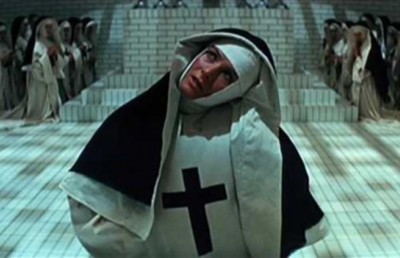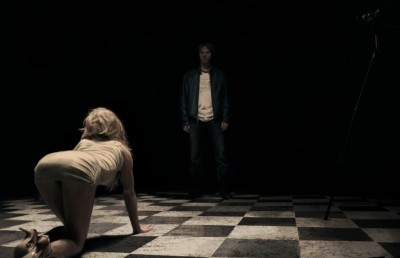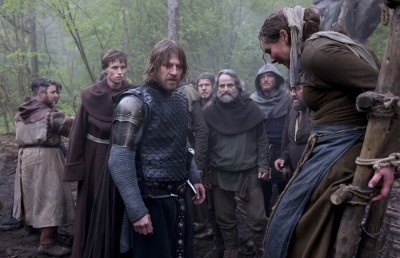An Interview with Dejan Ognjanovic
a reasoning voice behind Serbian horror
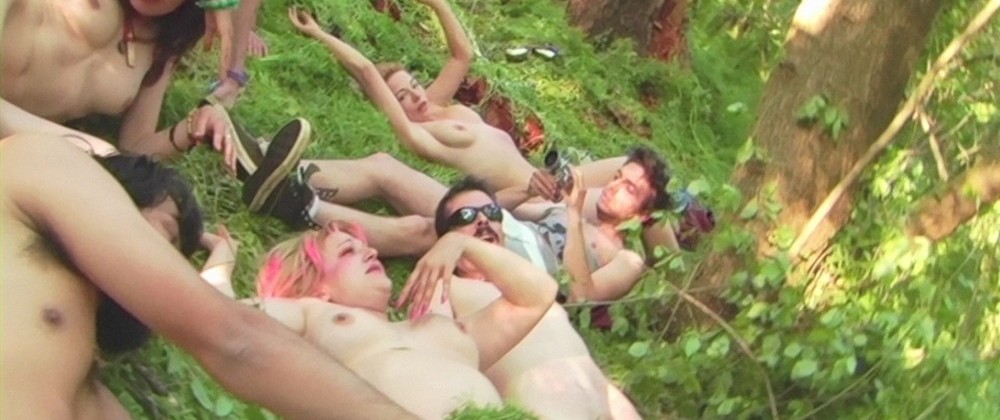
One of the highlights of the 2010 Fantasia International Film Festival was their spotlight on Serbian horror film, “Subversive Serbia”. Even seasoned horror fans, which comprise a majority of Fantasia regulars, would not have been familiar with the horror legacy of Serbia, which made the spotlight an invaluable genre education. Fantasia never does things halfway, so the spotlight included seven films spanning the classical and more recent eras, several invited filmmaker guests, and a Serbian film critic to place the films in their proper context. The older classical films were Variola Vera??(1982, Goran Markovic), ??A Holy Place (1990) by veteran director Djordje Kadijevic, and T.T. Syndrome??(2002, Dejan Zecevic) and the newer crop were represented by ??Tears for Sale??(2008, Uros Stojanovic), ??The Life and Death of a Porno Gang (Mladen Djordjevic, 2009), the first Serbian animated feature Technotise Edit & I (2009, Aleksa Gajic) and ??A Serbian Film??(2010, Srdjan Spasojevic ).
Invited guests for the spotlight included screenwriter (of Tears for Sale and A Serbian Film) Aleksandar Radivojevic (who provided some lively and very frank introductions –too frank for one argumentative audience member on one evening–), director/writer/co-producer (Srdjan Spasojevic ) and producer (Nikola Pantelic) of A Serbian Film, producer Zoran Otasevic (A Holy Place [he was expected but at the last moment was unable to come] director Mladen Djordjevic (The Life and Death of a Porno Gang) and film critic and author Dejan Ognjanovic, who was kept particularly busy by Fantasia administration hosting a Q & A for nearly every screening, a panel discussion with the noted Serbian guests, and giving his own special multimedia presentation “An Introduction to Serbian Horror Cinema.”
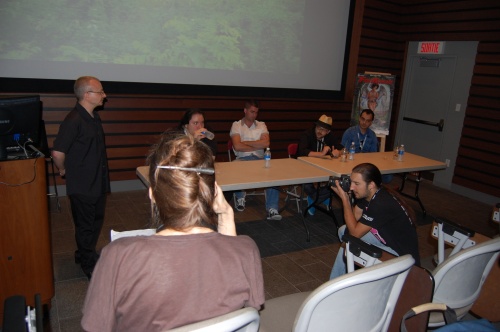
Dejan Ognjanovic (left) Moderating Panel on Serbian Horror Film
Collectively the films were remarkable in their stylistic and thematic diversity, ranging from dark gothic fantasy (A Holy Place), lighter magic realism styled fantasy (Tears For Sale), reality-based viral horror (Variola Vera, loosely based on a real Kosovo event from 1972, in which an epidemic was started by an Albanian from Kosovo, but the event depicted in the film deals entirely with the epidemic in a Belgrade hospital), generic, slasher-styled horror (T.T.Syndrome), and different strains of metaphorical horror, documentary/mockumentary (The Life and Death of a Porno Gang) and graphically violent and highly stylized (A Serbian Film). The latter film was by far the stand-out in terms of exposure and media coverage, arriving with a harrowing pedigree as a film to shatter the nerves of even the hardened horror fan. For once the advance notice was not an exaggeration, at least on the level of visceral and unflinching reality horror, with the mixture of pornography, snuff and violence taken to extreme levels. I was, however, quite surprised (based on the advance press) to learn that the film’s hard edge gives way to a slow progression toward a subjective, surreal first-person experience which takes the edge off some of the more unpleasant violence. If ever there was a film that challenged the notion that violence is not exploitative if it is justified by narrative force, A Serbian Film is it. Some of the film’s most extreme imagery is a result of making literal the expression that a people (in this case Serbians) are screwed from the day they are born to the day they die (and afterwards). The Life and Death of a Porno Gang is an interesting mixture of Dusan Makavejev’s WR: Mysteries of an Organism and George Romero’s Knightriders, where porn/sex replaces chivalry. The former is expressed by the equation of sexual freedom with political freedom (the Makavejev influence). A young filmmaker (Marko, in uninspired video diary style) wants to make ‘art’ porn films but his producer says it won’t sell, and urges him to make straight porn or comedy. When he alienates the Serbian porn producer he is forced to leave Belgrade with his girlfriend Una. He rounds up a motley group of porn stars (a la Dirty Dozen) to take to the country with a porno caravan that does live sex theatre. The group includes a gay couple with Aids, a couple addicted on heroin, a transvestite who turned to bestiality because of an abusive father, an overweight woman, etc. In true caravan fashion, every type of sex is expressed –straight, gay, bestiality. As can be expected, they aren’t exactly welcomed with open arms by the older rural crowds they play to, even being theatened physically by a torch bearing gang (a la Universal studio). A shady older German man runs a private snuff film enterprise, where he provides snuff films for wealthy foreigners. He offers this as an ‘art’ expression to the young filmmaker, ensuring him that only willing people who want to die as a form of ‘suicide insurance’ to provide money to loved ones, will be used. They reluctantly agree to do a few just for the money. The first victim/subject is a young man, disaffected by his family and life in general. The second victim/subject is a man haunted by his war crimes, who cuts himself across his chest and is then finished off with a blunt object by the dark haired gay man. This first few suicide snuffs are emotionally wrenching. Another ‘volunteer’ wants money for an operation to remedy his granddaughter’s facial disfigurement, caused by the war. The victims are at first openly at ease and willing, but even at that, the decision becomes too emotionally draining on them. In the end, the filmmaker and his girlfriend do a final snuff film (after first killing the snuff producer) and then perform a double suicide (while –ironically?– holding a religious icon). My own personal favorite was the more classical yet still subversive A Holy Place, an adaptation of the same Gogol short story that was the source of the Russian film from 1967 Viy, which played at Fantasia in 2006. A Holy Place adds (to the Russian film) a complex flashback structure (which is set off with a sepia color palette), a lesbian subtext, incest (an insensitive father who lustfully paints nudes of his daughter), a powerful female character (the mentioned daughter), who returns as a seductive female witch with a ’castrating’ heel she puts to good use), and a haunting, repetitive, synthesizer-based score by Lazar Ristovski. The whole “Subversive Serbia” experience was made that much more enlightening by the rational and reasoning presence of film critic Dejan Ognjanovic (who, as I got to know him over the days of the festival, was jovial, charming, and generous). I sat down with Dejan Ognjanovic to talk about the past and present of Serbian horror.
Donato Totaro: I’ve really been enjoying your lectures and introductions to the films. At first I thought, Serbian horror, there is a whole wealth of films available, but in fact there are only about a dozen or so films.
Dejan Ognjanovic: If we are talking about horror, yes. The number would be around 15 or 16. Including TV films. And I must stress this detail. These TV films were made by people who had previously done film or were done in a way that was not typical of how TV films were made, like Dan Curtis’ films of the 1970s for example [see list of representative films at the end of the interview, taken from Dejan Ognjanovic’s blogspot The Temple of Ghoul.]
DT: In the clips you showed during your presentation (“An Introduction to Serbian Horror Cinema”) the TV films seemed more interesting than some of the feature films, especially Strangler vs Strangler.
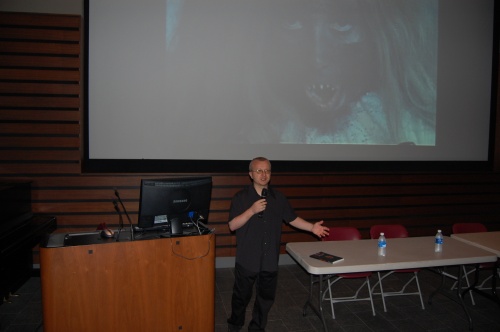
Dejan Ognjanovic in Presentation Mode
DO: Yes. That is why I included them as well. The running times may be tricky because some of them are 62 to 65 minutes but in terms of structure, of how they were shot, the locations, the use of cinematic language, they are closer to film than to TV drama.
DT: The first one is She Butterfly, 1973, which was a Yugoslavian production. Nothing before that?
DO: There was one based on a fairy tale. It has some spooky moments as most fairy tales do, it is called Miraculous Sword (Čudotvorni mač, Vojislav Nanović, 1950), which was based on a very well known folk tale [click here for Dejan Ognjanovic’s overview of the film]. . The story, “Baš Čelik,” was one of my earliest influences that attracted me to horror. It is about a creature, it is never specified if it is a creature or man with superhuman powers. It is humanoid and is imprisoned in the beginning of the story in a casket, an iron maiden. The young hero inadvertently helps the creature by giving him water and he slowly comes to life with each glass he drinks. It was made into a film around 1950. It was very successful and there are horror or supernatural elements, like talking decapitated heads, witches. But for some reason, fantasy was not really encouraged or if it was, it was intended for children.
DT: Well if you look at the history of films in Communist countries, with socialist realism as the state art it was difficult to veer away from that.
DO: Yes but at least the Russians and Poles and Czechs had a rich tradition of fantasy films, many of them intended for kids but there were also some surreal, dark-fantasy films for adults. They could get away with it. But I’m afraid not so in Serbia, where majority of filmmakers just didn’t care for such themes, even if it weren’t for the “official” communist aesthetics which was not supportive to any kind of fantasy.
DT: Given what has happened in Serbia since 1990 or so, with the social horrors, because of this same reason a lot of the films I’ve seen here, except for Tears for Sale, contain some very brutal violence, unrelenting and visceral but never exploitative, so I’m thinking maybe that is because people from that generation can not take violence lightly, violence has to be painful.
DO: Yes, violence is not fun, that is one of the lessons we all learned. In America and in some safer parts of the world violence can be fun because you live in a relatively safe environment so the violence could be exotic. The violence is Serbia was not exotic. It was not out there somewhere. It was in your neighborhood, your home.
DT: Whereas in some of the earlier films, like A Holy Place, at least there was some fantasy and supernatural there. The possibility was there before the social circumstances took that away in a sense. So in a way I guess it is very difficult since these few films are coming from different historical moments to come up with a generalization of what Serbian horror films are like, in the way you can say, for example, Italian horror films are stylized, and they don’t care too much about the narrative.
DO: One tendency which is pretty dominant is realism. With a few exceptions such as She Butterfly and A Holy Place, all of them are either ambivalent about the possibility of a supernatural explanation or are thriller/drama kind of realistic horror. That is the problem, the tendency to have everything grounded in reality so it can be recognizable as something that could happen. Serbian audiences have a problem suspending their disbelief for something that is outrageously supernatural or fantastic.
DT: It is interesting with A Serbian Film that it does start off realistically but then it becomes more of a subjective experience –how much is real or in the character’s mind– it becomes almost one of these ‘mind fuck’ films.
DO: It does get surreal. It goes from realism to surrealism. In general, Serbian filmmakers may not go for outright supernatural but they do allow for subjective, surreal and grotesque elements to provide additional colors to the reality.
DT: You don’t have that in Life and Death of a Porno Gang, which is more realist, but definitely in ??A Serbian Film??…which I’m sort of looking forward to watching again, as much as you can look forward to that film! Of the many other international horror cinemas is there one that has been more influential to Serbian horror?
DO: Roughly speaking, you can break it down to two groups of films and directors. Classical directors and modern, younger directors. Directors like Djordje Kadijevic (She-Butterfly, A Holy Place), Branko Pleša (The Damned Thing), Goran Markovic, Slobodan Šijan… who did their major works while the country was still Yugoslavia (that is, until 1991) you can call classical. They are now middle-aged or elderly, like Kadijevic. In the Kadijevic’s case, his influences are Masaki Kobayashi, Kaneto Shindo, and classic American horror, although his main influences are literary. Goran Markovic (Variola Vera, 1982, Reflections, 1987) is one of those Prague students, the Prague school of realism like Emir Kusturica and other Serbian directors who started working in the latter half of the 1970s and early 1980s. Their influences were also more European, Czech, Russian. So Markovic took elements from American horror films but placed them into this Eastern European realism, which is more Czech-inspired than anyhing else. Then you have the younger generation, the new films like T.T. Syndrome (Dejan Zecevic, 2002) and Sheitan’s Warrior (Stevan Filipovic, 2006) and Zone of the Dead (Milan Konjevic, Milan Todorovic, 2009). This generation was predominantly influenced by the Western, mostly American (and Italian) horror films. Dario Argento is pretty important for the new generation of Serbian filmmakers. I couldn’t imagine anyone liking horror and not liking Argento. He is very big in Serbia. He came to Serbia a couple of years ago for a retrospective of his films and to receive an award from the Belgrade cinematheque, and he was stupefied by how many people asked for autographs.
DT: There is also Mario Bava who did Black Sunday (aka Mask of Satan) based on the Nikolai Gogol short story.
DO: Yes, but Bava’s film is so loosely based on Gogol the story is unrecognizable. There are some scattered elements, but used….very loosely. Now that you mention Bava, there is an interesting detail which audiences outside Serbia may not even notice, because you have to be Serbian and read Cyrillic, but there is a scene in Black Sunday [which is set in Moldova, ed.] where the inscription above the inn reads “Gostionica” in Serbian Cyrillic (Гостионица), and “The Family of Wurdalaks” (in Bava’s omnibus Three Tales of Terror, aka Black Sabbath) is the closest that Western audiences could see horror based on Slavic folktales and beliefs, as exemplified in She Butterfly. There is a strong tradition of beliefs in vampires in Serbia – the Serbian word “vampir” was spread into the West after an official Austrian report on a vampire epidemic in a Serbian village in the early 18th century was published and widely translated throughout Europe. In classical Western literature and horror films the vampire is an intruder who comes from abroad, an invader of your home and your country, whereas in Serbia this entity is closely related to family. He doesn’t bite strangers but family members, cousins, neighbors, as seen in the family of Wurdalaks in Black Sabbath and She Butterfly, and in A Holy Place.
DT: That is interesting because in Stoker’s novel the vampire is a count, an aristocrat and that deals more with colonialism and aristocracy. I also noticed in the clip you showed from She Butterfly that it had an almost identical scene where the witch or vampire is riding the man on her shoulder like in A Holy Place. I can’t remember that in any other horror film. Is that action in other Serbian horror films?
DO: This particular image has to do with the notion of mora. “Mora” in Serbian is a sort of witch that is connected to disease, to fever, a sort of feverish pestilence riding you, tiring you. This is the real life inspiration – fevers, pests – and then there is a creature which represents it. So it is not really a witch as in western terms like black magic, sacrificing people, dealing with the Devil, but more akin to a succubus. That would be the closest parallel. It is not something the director invented or has a fetish for but it is derived from the Slavic folklore, and thus seen in both Russian and Serbian film.
DT: In the Russian Viy she rides a broom so it is more like a conventional witch.
DO: It has been a while since I’ve seen that but I think she also rides him.
DT: I’ll have to go back to see it too. [Upon verifying my Ruscico DVD, the witch definitely rides him in Viy. Your memory was right Dejan!]
DT: So we can see this as one of the Serbian folktales that appears in the films. Are there any others?
DO: I spoke yesterday about the mill as a place where the vampires and other dark, unclean forces gather. But there are not that many films where they reference that. I could talk for hours about interesting Serbian folktales but there are no horror film equivalents. The potentials of the rich tradition of beliefs were rarely used as motifs and images in Serbian films, even in literature they were scarcely used. It is a mine waiting to yet be exploited [Dejan spoke about these myths in his presentation]. After the liberation from Turks in the 19th century the myths were all about enlightenment, education, reason, science, doing away with superstition. And then again when the communists came it was again: away with superstition, fantasy, no inventing things. Realism and pragmatism and materialism were need to rebuild our country after it was devastated in the World War 2. We need science and reason, not fantasy, so all these folk beliefs were side-stepped in reality, and in art too.
DT: They were suppressed.
DO: It was not so much actively suppressed, in terms of censorship and the like, because there were not many people who felt like doing fantasy. It is not like in the 1950s and 1960s we had dozens of directors wanting to make horror films and the government said, “No, you must make films about workers.” It was the cultural climate and the prevailing frame of mind, including the artists working at the time.
DT: The older generation, the classical directors, are they still able to work?
DO: Goran Markovic is still active but his recent films are not that good. I think, as Alexander Radivojevic said last night, he peaked with Deja Vu (aka Reflections). It is his last great film. You may know his film Tito and Me (1992), which had a solid exposure in the West. And Djordje Kadijevic who did She Butterfly, is still trying to get work. He is 77 or so but is still active, still plays sports, but he had a long period of inactivity. His last film was made for TV, in 1993. He also had a personal tragedy and just lost contacts and you had to be connected to make films in Serbia. He was away from that for too long and was not interested in politics and parties. He has great scripts, some of them supernatural horror, some grotesque weird historical ones, but it is heartbreaking to know that these great scripts exist and will never be filmed because some are very ambitious and would be expensive to make. I’m actually working on a book of his unfilmed screenplays because I think it is a shame if they just remain in his closet, unread.
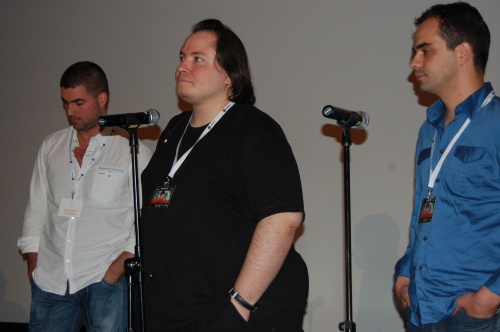
Srdjan Spasojevic, Aleksandar Radivojevic and Nikola Pantelic on stage before A Serbian Film
DT: I can see some of these great ideas….
DO: You can say Serbia is a country of great potential, a lot of it being wasted, either because of stupidity of the people in charge, or limiting circumstances. You constantly feel tied. It is not like in Canada, Italy or France, where you have an idea, you write the script, get the money and go out and shoot it. Of course, it is a difficult business anywhere, but in Serbia you feel tied by some additional bondage you don’t have elsewhere. You have to be really determined and a masochist, ready for sacrifices. It is frustrating. I admire these filmmakers, and I’m thankful that they exist and keep making these films.
DT: The suffering artist. Seems like it is a small community of filmmakers. Do the horror directors know each other?
DO: Yes, because they are all in Belgrade. In Serbia everything is in Belgrade. Not only movies. If you want to study film the best schools are in Belgrade, same for making films, productions, etc. It is sad because the potentials for visuals outside of Belgrade is impressive. You saw the photos of those old graveyards, the countryside, that Djordjevic explored in The Life and Death of a Porno Gang. These places are almost unknown to those who are limited to Belgrade. They have a fear of going outside to the countryside. In his introduction to Tears for Sale you heard Aleksandar say how “there is Belgrade and darkness and wilderness around it.” He’s a good example of this attitude that everyting is in Belgrade and there are cannibals and tigers outside of Belgrade. So because all of them are in Belgrade they know each other and even collaborate, but being Serbs there are also clashes, sparks. However, they are not so closely connected to be called a new wave, as some Serb critics are writing. I wouldn’t say that two films created in the same genre or with similar themes, like The Life and Death of a Porno Gang and A Serbian Film constitute “a wave”. They are very different films, even if they have these thematic similarities: snuff, violence, pornography, death, brutality. It is an accident. Their next films may very well be different. They are feeding on the same anxieties, frustrations, nightmares but they are expressed in different ways.
DT: Of those two films would you say one of them is more political than the other?
DO: The Life and Death of a Porno Gang is obviously more political.
DT: There is also a lot of religious imagery in The Life and Death of a Porno Gang. During the double suicide they are holding this icon.
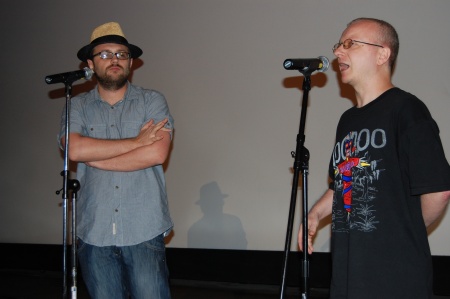
Mladen Djordjevic and Dejan Ognjanovic on stage
DO: There was this moment on the first viewing that seemed to come out of nowhere when one of the guys decides to stay with those priests. I guess maybe the director Mladen would be the right person to ask what he wanted to convey with that message. I guess it was meant as one option which may work for some people, but not everyone, to find some peace and solace with the church. But it is insufficient for the main character. I believe the icon has an effect of irony, because the saint it represents is supposed to be the protector of travellers – and they are at the end of their road, and it leads them to suicide. And suicide is a very un-Christian thing, it’s a sin. And the place they choose to kill themselves, it predates Christianity, it’s from the times when Romans occupied this region. So, perhaps the ending means that they’re going back to some kind of pagan past.
DT: I also noticed in a brief shot a recreation of the last supper and there is also an icon on the wall that looked like an Andrei Rublev. We see it briefly.
DO: In the home of that elderly man who was supposed to be killed in front of his family?
DT: Maybe I can’t remember for sure.
DO: In that scene there was a juxtaposition of Slobodan Milošević and an icon. In the same shot. Because many people saw him as the next savior, well maybe savior is too strong a word, but the new Karađorđe [Petrović], the leader of the uprising against the Turks, who was decapitated by his closest (Serbian) cousin. He was the Serbian hero and Milošević for a while seemed to be the new hero. So there is a mockery of that idea of Milošević next to an icon.
DT: Was the German producer meant to look a little like Milošević?
DO: No, I don’t think so. I just think they found a suitable actor for that role. It is funny because someone else thought that the German guy looked like Ruggero Deodato, he asked Mladen if he was cast to look like the director who made Cannibal Holocaust. So who knows who the next journalist will see in him. It wouldn’t make sense because he is presented as a German, a foreigner, someone coming into your country to exploit the violence to sell it abroad. And Milošević did not come from outside.
DT: Just another question on The Life and Death of a Porno Gang. I see a strange parallel to a film that is quite unlike it in many aspects. Have you seen the Romero film Knightriders?
DO: No I haven’t.
DT: It deals with these characters that are very disconnected from society, modernity.
DO: Yes I know what it is about: recreating medieval battles.
DT: They go off on tour and create this little caravan, so it kind of reminded me of The Life and Death of a Porno Gang because there too you have characters who have something they believe in very much that no one else does.
DO: Yes a bunch of idealists clashing up against reality. Trying to put certain ideals into practice and failing. I’m guessing since I don’t know how it ends!
DT: Yes it fails.
DO: Well that is the doom of idealism and idealists. That is why we have so much cynicism in Serbian films. Ambrose Bierce defined a cynic as a ‘disappointed idealist.” So you might say that Serbia is a nation of disappointed idealists. For a while Serbs believed in communism, in a better life and rosy future of brotherhood and unity among the peoples of Yugoslavia. Yugoslavia was a kind of utopia that was largely created and supported by the Serbs. Those other republics, and now “independent” states, used the opportunity because they saw something pragmatic in it because, as you may know, the Croats and Slovenes fought on the side of the Austria-Hungary in World War 1, and after World War 1, after Yugoslavia was created, they were kind of pardoned for collaborating with Austria-Hungary. Instead of being divided between Italy and Hungary, they were united with Serbia, and Serbia of course fought for the ‘good guys’, against the Germans. The same happened again in the Second World War, when Croats and Slovenes again sided with the Germans, committed numerous attrocities (just google the word “Jasenovac”…) and again were pardoned for genocidal crimes that were committed by the Ustashe [Croatian Revolutionary Movement] in Croatia. These two states became parts of the new, socialist Yugoslavia, centering around Serbia as the largest state. Again they paid no price for being German allies and killing for them, and the consequences of that are the civil wars in which those two republics were most anxious to leave Yugoslavia once they no longer needed it.
DT: With Tito the famous thing that we remember is that he was someone who had his own identity and resisted Stalin.
DO: Yes he was one of the founders of the non-alignment movement. Non-aligned countries, mostly African. It was all very idealistic and well intentioned but obviously the superpowers did not want a strong non-aligned state in such a geographically important position as Yugoslavia had. You know that Latin rule: divide and conquer. The official version in the Western press is that you had all these stupid peoples that could not live together and fought amongst themselves. There was some of that, too, but if the West wanted to prevent the fightings, they could have, but they didn’t. Instead they chose to sell weapons to this state and that state and to support them. They would tell them, claim independence and we will support you. We will recognize you, which the Germans did, and thus enabled the outbreak of violence. In the beginning of the clashes and instability the United States were saying we support Yugoslavia, we support unity. But the whole thing is very complex. Eventually the common people suffered. People realize that, and obviously it was stupid to do it in such a violent manner. Many people realize now that it was stupid to break down this big powerful state into half a dozen small quasi-independent ones, they had friends and families, and marriages….
DT: And they had a really good soccer team….Yugoslavia…
DO: That is another thing. If we had one representative in basketball, which we are stronger in I think than soccer. If we were one country, man, no one could beat us in many sports.
DT: My friend Peter Rist wanted to ask me if you know the film teacher/historian Vlada Petric.
DO: Oh yes I met Peter the other night at the Irish Embassy. I don’t know Petric personally but I know of him of course. I met him briefly, but he would never remember me. He did great things. He was responsible for starting a Film School somewhere, not sure where….
DT: Maybe Harvard. And he was here in Montreal during the 1976 Olympics and taught a film course at Concordia which Peter took and it turned him on to film.
DO: Yes he told me that.
DT: Can you talk a little bit of your own work. I know you have a few books out. You showed us one the other day.
DO: Yes, the one I have here is called In the Hills, the Horrors: Serbian Horror Film (2007). It was my attempt to sum up the achievement of Serbian horror film up to now. It is divided into three parts. The first part deals with socio-historical, cultural background of Serbia, and the presence of fantasy and horror in literature and cinema, and obstacles for it, and I also address the issue of theory because there is no single book on horror as a genre translated or written in Serbia for students of film. If a student here wants to study horror film, he must know what other foreign critics and scholars have written about horror, and for that you have to buy a book in English, because there are none in Serbian. I also address how Serbian critics dealt with foreign horror films that played in Serbian cinemas and on TV and how they mostly fought against the presence of horror in Serbia in the 1970s, and 1980s. That was a sort of preparation and theoretical background. The longest part of the book is the one in which I analyze 14 Serbian horror films. There were 14 at the time of writing the book: 3-4 more were made in the meantime. This includes cast, full credits, running time, plot synopsis and my analysis, comparing the film to its predecessors, the director’s poetics, changes in adaptation (if there is a literary source), close reading of the film’s form and content, and I also address each film’s reception, quote the interviews that were available, etc. And the third part is made up of three long interviews, where I let the filmmakers speak. I have an interview with Djordje Kadijevic, as an example of classical horror, and Dejan Zecevic, director of T.T. Syndrome as representative of the younger directors and an interview with a young critic who was known for defending genre films. I also have a book on the devil in cinema, Faustian Screen: The Devil in Cinema (2006). That one doesn’t deal only with horror cinema, but films of all genres which had Devil as a character or Satanism as a theme. I also have essays, mostly about horror literature and film that were published in various journals. [For a full bio visit his blog]
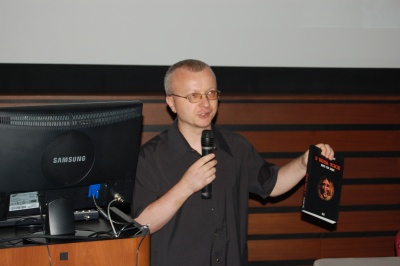
Dejan holding up his book on Serbian horror film
DT: All of this is in Serbian I imagine.
DO: Yes, but I am also active in English. I wrote for several books edited by Steven Schneider, like 100 European Horror Films, 101 Horror Movies You Must See Before You Die, etc. I have six essays in 501 Movie Directors, I will hopefully be in the second edition of Fear Without Frontiers with my essay on Serbian horrors. I have an essay that is still not published, but I’m pretty happy with it because it is the best thing I have written in English, on Haute Tension. This is the essay in which I try to defend the twist…which for me is the whole point of the film. I wrote for the online magazine Kung Fu Cult Cinema for several years before it fell apart. I reviewed Asian dvds and a few books there, and wrote for BeyondHollywood.com. There is my essay on Serbian genre cinema in a serious online journal that is dedicated to Eastern European cinema, KinoKultura.
DT: Variola Vera is the only one playing at this retro I have not seen yet. Is there any other important Serbian horror films not playing here that we should be aware of?
DO: The Backbone, which is not technically horror but I analyze it as a horror film. It is like Serbian Shivers. It is more on the side of existential/arty horror because Shivers is more exploitation, with horror and nudity. There is some nudity in The Backbone but the film is more metaphysical, existential and well worth watching. A Man to be Killed was made in Yugoslavia, a co-production between Montenegro and Croatia with a lot of Serbs in it. Back when I was writing this book the country was still called Serbia and Montenegro but when Montenegro decided to be a separate state, I did not want to exclude this film from the book because I think it is interesting, and it features many Serbian actors and technicians. The same guy who did the sets for Tears for Sale did this one and he is really the best set designer we ever had. The Hell he designed for this film, because parts of it take place in Hell, it is stunning. Full Moon Over Belgrade is a poor film, you are not missing anything, as is Zone of the Dead. Outside of some of the made for TV films, like The Protected, which is a very good film, you are not missing that many key films. Maidenly Music is so-so and it would be ok to see because it has some interesting things in it. The Dream of Dr Mišić is pretty good.
DT: The clips you showed for that one looked fantastic, with those vampyrs. It looked a bit like a Carl Dreyer film.
DO: And The Damned Thing is also very good. A Bierce adaptation.
DT: The clip for Strangler vs Strangler looked good too. The actor looked like a cross between Peter Lorre and Hitchcock!
DO: That’s Taško Načić, one of the best Serbian comedians. He’s quite a presence, he’s great.
DT: Just one comment on Tears for Sales. The one thing that struck me about that film, and this is not meant to sound sexist, is how beautiful the women were, even the old women, in the sense of how they seemed to mirror the formal beauty of the film. Especially the three central ones and they were shot in a way that made them seem like animated angels. The perfect complexion, facial features.
DO: Yes there is this stereotype about Slavic women being slavish, even the word derives from Slavic…Hitler wanted to exterminate Slavs because he thought they were subhuman or something and you see how wrong he was! Yes, that is another thing that Serbia is known for: beautiful women. And the DP did a good job of lighting them but they were real women, no photoshop! You could see other films with them in it
DT: The way the three women interacted in the first twenty or so minutes, with their cigars, this carmaradierie reminded me of The Good, the Bad and the Ugly.
DO: There are definitely western elements in it. The director’s first short film, maybe as a student, is called Gallows for Two, and it is directly influenced by spaghetti westerns. The sunburned stones, desert images, you won’t find a lot of places in Serbia like that….
DT: Neither in Italy since spaghetti westerns were mostly shot in Spain.
DT: In some respects, as you’ve defined it, A Holy Place is an old-fashioned classical horror film but with its themes, it was quite subversive. You have the theme of incest, which was fascinating.
DO: And the lesbianism….
DT: Which probably came from Hammer?
DO: No, no. The director has not even seen 10 horror films in his life. His main inspiration is from literature and art. He is an art historian by vocation and education. It was not for the sake of exploitation. It is more like 19th century French literature, the decadence, like Théophile Gautier. Certainly not Hammer films.
DT: The film uses a lot of clear POV shots, especially in the flashback, where the man sees what the father is hiding inside the chest, the daughter sees the father, and the young protagonist sees the father lusting over the nude portrait of his daughter.
DO: Yes there is a lot of voyeurism. Seeing behind doors, through windows, around walls, like when the main character sees the painting.
DT: Is it meant to suggest a reflexive gesture, a comment on spectatorship or is it dramatic…
DO: Well part of it is dramatic because you need those flashbacks so someone has to tell the story, and the story is valid only if it comes from first person witness, so you must have three witnesses to three events. But you can also relate it to the spectatorship and voyeurism of horror because there is this perversion running throughout, even with the old woman coming to the guy: although she doesn’t come with sexual interest that is how he interprets it. Even riding can have sexual overtones. I guess part of it is from the story itself, part is from the genre which is especially open to those subjects.
DT: Someone after the screening said that one of the possible interpretations is that the mother is possessing Katerina, but if that was the case wouldn’t the father be attacked as well. Wouldn’t the wife want to get back at the father for cheating on her with their daughter?
DO: Well she seems to be avenging herself against the whole male species…
DT: But not the father.
DO: Well, it is like she is keeping him for the end, but he remains unpunished, you are right.
DT: I think that has been my favorite of the Serbian films I’ve seen. The image when she is standing over the man and lifts up her garter and stamps on his genitals, it is sexy and painful at the same time.
DO: It arouses you and then brings you down.
DT: This director knows what he is doing.
DO: It is very erotic. Her movements. There is even an almost necrophilic aspect. She is really beautiful. When she steps out of the coffin and her skirt is back at the coffin and for a moment you see her whole leg. It is sexy and creepy at the same time.
DT: Yes it is much sexier than the Russian version, Viy, allowing the twenty year difference. In some ways I prefer the Russian version, the stuff in the barn, before the third night which is a bit crazy, but I prefer most of almost everything else about the Serbian version. I found there was too much forced humor in Viy. With A Holy Place you know right from the beginning that there is something that is going to happen, there is more suspense.
DO: Yes and any humour arises from the situation, like when he tries to escape from the guys. It strengthens the drama and the suspense. If you care for him you want him to escape, it is not buffoonery.
DT: Are there flashbacks in the Gogol story, because there aren’t any in the Russian version?
DO: I think they are referred to but they are not so elaborate as they are in the film. They are different. For example, in one of those flashbacks in the Gogol story you have this whole supernatural element of her turning into a black cat and sucking blood from a child or someone and here there is just brief allusion to the black cat but then there is this whole lesbian aspect which has nothing to do with the Gogol story.
DT: Even the way the flashbacks were shot in that sepia look is an example of how well thought out the film was.
DO: Well there is some critic from the website Twitch who disagrees, he hates this film, has a very negative review. Very hateful. Obviously the guy didn’t like it and didn’t understand it. Actually some of his criticism is partially valid: ok, it is not technically perfect, especially if he was expecting some Brian de Palma flashy type of direction, with camera movements all the time, quick cutting, decent budget and god knows what else. It is an old fashioned film, I agree, but there is so much good about it and he just hated it. He said he was expecting a hidden gem and he got a dull film. You can’t please them all. But it was negative in the excess. It is stupid, for example, to make fun of the film’s occasionally awkward subtitles.
DT: Yes as if the filmmaker had anything to do with them.
DO: It has nothing to do with the film itself. Blame the producer, the distributor, the translator. But I’m glad you liked it and most of the people I’ve spoken to have liked it. Not out of politeness but sincerely. I’m anxious to see how it plays the next two screenings.
DT: Well Dejan, I would like to thank you for your time and enjoy the rest of your time in Montreal.
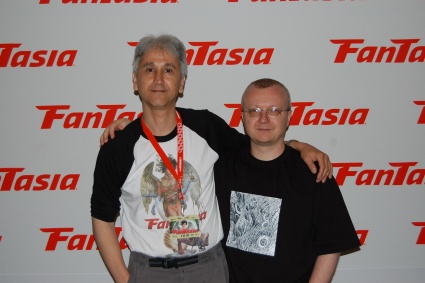
Author with Dejan
All photographs property of author
List of Important Serbian Horror (and Fantastic) Films
The She-Butterfly (Leptirica, TV, 1973, Djordje Kadijević, writer Milovan Glisic)
The Protected (Štićenik, TV, Djordje Kadijević, 1973)
Maidenly Music (Devičanska Svirka, TV, Djordje Kadijević, 1973)
The Dream of Dr Misic (San Doktora Mišića, TV, Branko Pleša, 1973)
The Damned Thing (Prokletinja, TV, Branko Pleša, 1975)
Gasp! aka The Backbone (Kičma, Vlatko Gilić,, 1975)
A Man to be Killed (Čovek Koga Treba Ubiti),Veljko Bulajić, 1979)
Variola Vera (Goran Marković, 1982)
Strangler vs Strangler (Davitelj Protiv Davitelja, Slobodan Šijan, 1984)
Déjà Vu aka Reflections (Već Viđeno, Goran Marković, 1987)
A Holy Place (Sveto Mesto, Djordje Kadijević, 1990)
Full Moon Over Belgrade (Pun Mesec Nad Beogradom, Dragan Kresoja, 1993)
T.T. Syndrome (T.T. Sindrom, Dejan Zečević, 2002)
Sheitan’s Warrior (Šejtanov Ratnik, Stevan Filipović, 2006)
Tears for Sale (Uroš Stojanović, 2008)
The Life and Death of a Porno Gang (Život i Smrt Porno Bande, Mladen Djordjević, 2009)
Zone of the Dead (Zona Mrtvih, Milan Konjević, Milan Todorović, 2009)
A Serbian Film (Srpski Film, Srdjan Spasojević , 2010)



